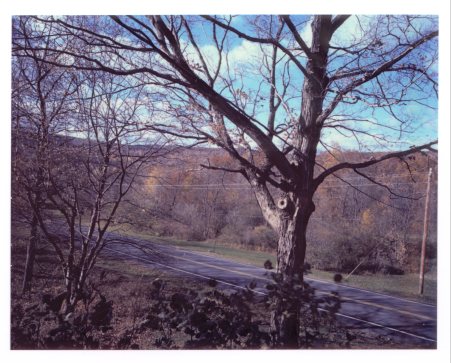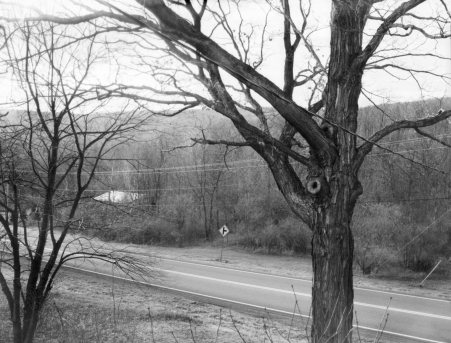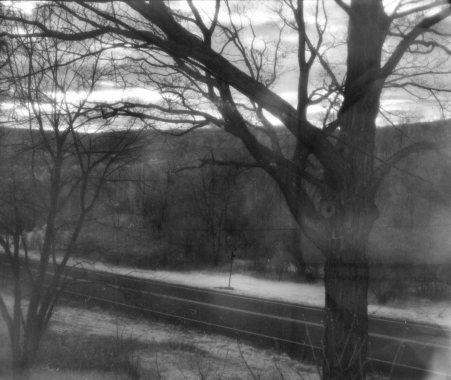

First experiences with Macophot IR820 infrared film
Infrared has held my interest for over 30 years. Never did much back then for various reasons. Mostly it was just too much trouble to load the film and have to shoot a whole roll before I could see any results. And it tied up the camera until the IR was finished... When I bought my LF Graphic, I realized I could load and shoot a single IR negative without affecting the use of the camera for the next shot. Unfortunately, Kodak has stopped producing their IR film in 4x5 format. After a quick search, I found what looks like the only IR film now available in 4x5 format, Macophot IR820c. It's rated at a speed of 100 to 400 depending on conditions. Yeah, that helps a lot... Infrared does have it's problems... After a lot of research and not finding all that much info, I tried a couple of shots. These were 'metered' for speeds of 6 and 3, taking a 4 or 5 stop difference of the #87 filter I was using. Again, not much info available here. Both negatives came out too light, one useless. The other useable but not good. Fortunately, my flatbed scanner really likes a thin negative...
The first problem I ran into was development using Kodak D-76 stock. I've heard dev times ranging from 5 minutes through 14 minutes. Maco recommends 14. I tried a strip test and thought 7 minutes looked right. I was apparently wrong as the film is thin and uneven. I would guess 9 to 10 would have been much better, and then maybe the exposure would have been correct? ;-)
The second problem was the film itself. It has a gel coating on the back that is supposed to be washed off before development. I did a soak with two rinses before development in the D-76. Used a stop bath and Kodak fixer. Then a half hour wash and a dip in photo flow and hung to dry. There was a nasty mess on the back of the negatives. Looked like someone rubbed a candle all across it, but it was much harder. Apparently a gel coating that came off only partly? And it didn't want to come off the rest of the way no matter what I did. But it had to if the negatives were to be used. After trying and failing with a number of solutions, I found that very hot water (hot-only tap water) softened it enough to be 'washed' off using a sponge. I've asked for opinions about this in the newsgroups but have yet to hear anything... I'll update this info if and when I find the problem or solution. Maybe it just wasn't washed enough before development? Or maybe too much??
Shown below are three photos. The first is a Polaroid Type 59 color. It wasn't shot the same day as the B&W, but from the same position and shows what the scene looks like in color. The second is a scan of a TMax-400 standard negative shot the same day and time (well, almost) as the IR. And the third is the Maco IR820 negative. All scanned on my flatbed at 1200dpi. Not the best scene for IR no doubt, but this is all still in the experimental stage.
| This shot hand held with the 90mm & type 59 film. |  |
| Here's a shot, same as above but with TMax 400 through the 135 Optar at f32 at maybe a 25th. A cloudy, hazy day... |  |
| Same shot, lens, time & place. Difference: Maco IR820 infrared film through an 87 filter. Yep, have to get exposure & development much better, but this is the first shot with the film! |  |
The B&W negatives were developed in Kodak D-76. As you can see, the IR has some problems but definitely shows traditional IR aspects such as white grass and deep contrasts in the sky. Getting the correct development times down is the first step, then the correct exposures.
Now to exposure. I know I shouldn't mention this until I've actually tested the results, but here goes. I've read much about metering for IR. It all seems like guesswork, even the filter factors for the opaque filters like the 87. I like to tinker and experiment... I've found that my Gossen Luna Pro F is extremely sensitive to IR and shows about a 4 stop difference when using an 87 filter. This is as close as anyone has suggested in the readings I've done. Next I tried it with the Sunpak 622 with IR head. This should be close because Sunpak lists the guide number of the head. Again, exposure through the 87 filter was right on as per guide number. It looks like you can place an 87 (or other IR) filter in front of the Luna Pro F and use it straight as an infrared meter! No more guess work as to how much actual IR light is out there.
But to buy a filter just for the meter? Well, I didn't have to. The 87 filter I did buy was for the Lee system. It cam un-mounted. I bought the plastic frames to mount it and found it to be about a quarter of an inch too large. Now I'm "stuck" with a 4 x 1/4 strip of #87 filter material... Yep, cut two little pieces off, glued them to a small plate cut out of an aluminum soft drink can (hole punched in plate!) and slipped into the slot in front of the meter. Now all I have to do to meter IR is slide the 87 in front of the sensor and away I go. And you just use the listed speed of the film. Of course that's 100 to 400 for the Maco.... After finishing this, I would recommend a thicker material for the slide though. I would probably use something like a match book cover with the filter sandwiched in-between two pieces of the slide. That should be about the right thickness for the slot in the front of the meter. I'll be making a new one soon...
Now, what about other meters? Like my Sekonic L-718 digital meters? They don't respond to the IR flash at all. No luck? Hmmm, what about that blue filter in front of the sensor! Okay, I have two so if I ruin one I'll only be drastically upset ;-) I removed the blue filter and tried the meter with a piece of the #87 filter. Yep, reads IR just fine! But it's about a stop off. Of course, the blue filter cuts down the light by one stop... Right in front of me was a piece of developed clear section of 120 film. I tried that over the sensor. Almost a half stop... Three pieces! One stop and back to dead-on accuracy. The sensor has to be protected anyway, so I cut three round sections of the 120 film and placed it into the hole that previously was occupied by the blue filter. This worked out nicely because the three pieces were about the same thickness as the original blue filter. Screwed the retainer back on and started some tests. My first concern was for flash metering since the tiny light that maintains the reading is under the retaining ring and goes through the 'filter'. It still works just fine with side-by-side comparisons to my other L-718. Then daylight and artificial light readings. Mostly accurate. "Mostly"? Well, the meter is now sensitive to the IR light so it does read some lighting a bit higher than the unmodified L-718. No more than a half stop so far though. But this could be a problem in other situations I suppose. But what about the Luna Pro? It's just as sensitive and also works just fine? Maybe I shouldn't worry? We'll see in practice...
So for now, it looks like an unmodified Luna Pro will work just fine as an IR meter. The Sekonic L-718 looks like it will work just fine after the modification. And it all cost me nothing because I had to cut a 1/4 inch strip off that filter anyway. This will all be seen in the near future after more negatives are ruined (I'm optimistic ;-). I'm sure many more meters could be used, modified or not. The real trick would be to find out the true speed of the film. And with the Maco film, the correct development time. But it sure may make taking IR photos a whole lot easier...
If anyone has and contributions they'd like to make about metering IR or Maco film, I'd be very happy to hear them and share them on this site... Hopefully, I'll find the time to do more testing and add to this myself. Real life can be a bummer sometimes ;-)
To get around our site, just click on one of the menu itemsabove.
Send e-mail to Rich
Entire site contents
© 1999-2015 South Bristol Views
Modified on